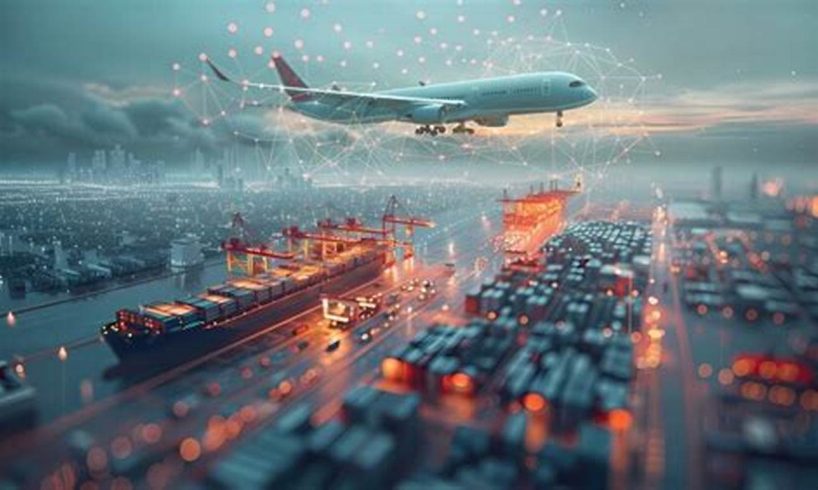
2000s technology logistics refers to the technological advancements and practices used in the logistics industry during the 2000s, a period marked by rapid technological progress and globalization.
This period saw the widespread adoption of information technology, automation, and supply chain management systems, which significantly transformed the way logistics operations were planned, executed, and monitored. These advancements led to improved efficiency, cost reduction, and increased visibility and control over the movement of goods.
Key aspects of 2000s technology logistics include:
- Warehouse management systems (WMS): Software applications that manage and optimize warehouse operations, including inventory control, order fulfillment, and space utilization.
- Transportation management systems (TMS): Software applications that plan and execute the movement of goods, including route optimization, carrier selection, and tracking.
- Supply chain management (SCM) systems: Software applications that integrate and manage the flow of goods, information, and finances across the supply chain, from suppliers to customers.
- Radio frequency identification (RFID) technology: A wireless technology that uses radio waves to identify and track goods, enabling real-time visibility and inventory management.
- Automated guided vehicles (AGVs): Driverless vehicles that move materials within warehouses and distribution centers, improving efficiency and reducing labor costs.
The adoption of these technologies in the 2000s revolutionized the logistics industry, enabling businesses to respond more quickly to customer demands, reduce costs, and improve overall supply chain performance.
1. Automation
The adoption of automated systems in the early 2000s played a significant role in revolutionizing warehouse operations and reducing labor costs. These systems, such as AGVs and ASRS, brought about several key advantages:
- Increased efficiency: Automated systems operate with precision and speed, reducing the time and effort required for tasks such as inventory management, order fulfillment, and storage. This increased efficiency leads to faster throughput and improved productivity.
- Reduced labor costs: Automated systems eliminate the need for manual labor in many warehouse processes, resulting in significant cost savings for businesses. This allows companies to allocate their labor resources to other value-added activities.
- Improved accuracy: Automated systems are less prone to errors than manual processes, as they follow pre-defined rules and algorithms. This reduces the risk of incorrect inventory counts, misplaced items, and shipping errors, ensuring higher levels of accuracy.
- Enhanced safety: Automated systems can operate in hazardous or confined spaces, reducing the risk of accidents and injuries to human workers. They can also handle heavy or bulky items with ease, minimizing the potential for physical strain.
The implementation of automated systems in warehouses during the 2000s was a major step forward in the evolution of logistics technology. These systems paved the way for further advancements in warehouse automation and continue to play a vital role in optimizing warehouse operations and reducing costs.
2. Data analytics
In the context of 2000s technology logistics, data analytics played a crucial role in transforming supply chain operations and driving efficiency. Advanced data analytics tools empowered businesses to harness the vast amounts of data generated throughout the supply chain, enabling them to uncover hidden insights and make more informed decisions.
- Identification of inefficiencies: Data analytics tools allowed businesses to analyze operational data, such as inventory levels, order fulfillment times, and transportation costs, to identify areas of inefficiency. By pinpointing these bottlenecks, companies could implement targeted improvements to streamline processes and reduce waste.
- Optimization of routes: Data analytics enabled the optimization of transportation routes, taking into account factors such as traffic patterns, fuel consumption, and delivery schedules. This optimization led to reduced transportation costs, improved delivery times, and lower carbon emissions.
- Improved decision-making: Data analytics provided businesses with a comprehensive view of their supply chain performance, allowing them to make data-driven decisions. From demand forecasting to inventory management, data analytics empowered logistics professionals to make informed choices that maximized efficiency and profitability.
- Predictive analytics: Advanced data analytics techniques, such as predictive analytics, enabled businesses to anticipate future trends and events. By analyzing historical data and identifying patterns, companies could proactively prepare for disruptions, optimize inventory levels, and make informed decisions about future investments.
The integration of data analytics into 2000s technology logistics marked a significant step forward in the industry’s evolution. Data analytics tools provided businesses with the insights and capabilities needed to improve their supply chain operations, reduce costs, and gain a competitive edge.
3. RFID technology
Radio Frequency Identification (RFID) technology emerged as a revolutionary tool in 2000s technology logistics, transforming inventory management and supply chain traceability. RFID tags, small electronic devices attached to items or packaging, use radio waves to transmit data, providing real-time visibility into the movement and status of goods.
- Enhanced Inventory Management
RFID technology enabled businesses to track inventory levels in real-time, eliminating the need for manual counting and reducing the risk of stockouts. This improved accuracy and efficiency in inventory management, leading to reduced waste and improved customer service.
- Optimized Supply Chain Visibility
By tracking the movement of goods throughout the supply chain, RFID technology provided end-to-end visibility. This enabled businesses to identify bottlenecks, optimize transportation routes, and respond quickly to disruptions, resulting in improved supply chain efficiency and reduced costs.
- Improved Traceability and Compliance
RFID tags provided a reliable and tamper-proof method for tracking goods, ensuring product authenticity and preventing counterfeiting. This enhanced traceability also facilitated compliance with regulatory requirements and improved product recalls, protecting consumers and businesses alike.
- Automated Processes
RFID technology enabled the automation of various processes in the warehouse and supply chain. Automated identification and tracking of goods reduced manual labor, improved accuracy, and increased overall efficiency, leading to cost savings and improved productivity.
In conclusion, RFID technology’s real-time visibility and enhanced traceability transformed 2000s technology logistics. By providing businesses with greater control over their inventory and supply chain operations, RFID technology paved the way for new levels of efficiency, cost reduction, and customer satisfaction.
4. Cloud computing
The adoption of cloud computing in the early 2000s had a profound impact on technology logistics. Cloud-based solutions provided businesses with a range of benefits that transformed their operations, including scalability, flexibility, and cost savings.
- Scalability
Cloud computing offered logistics providers the ability to scale their IT resources up or down on demand, based on changing business needs. This scalability eliminated the need for costly investments in on-premises infrastructure and enabled businesses to handle fluctuations in demand without disruption.
- Flexibility
Cloud-based solutions provided logistics providers with greater flexibility in managing their IT resources. They could access applications and data from anywhere with an internet connection, enabling remote work and collaboration. This flexibility was especially valuable for logistics operations that span multiple locations or require real-time access to information.
- Cost savings
Cloud computing offered significant cost savings for logistics providers. By eliminating the need for on-premises infrastructure and IT staff, businesses could reduce their capital and operating expenses. Cloud-based solutions also provided pay-as-you-go pricing models, which allowed businesses to only pay for the resources they used.
In conclusion, the adoption of cloud computing in 2000s technology logistics transformed the way businesses managed their IT resources. Cloud-based solutions provided scalability, flexibility, and cost savings, enabling logistics providers to operate more efficiently and respond more effectively to the demands of the modern supply chain.
5. Collaboration platforms
In the context of 2000s technology logistics, collaboration platforms emerged as a crucial component, revolutionizing the way supply chain partners communicated and shared data. These platforms provided a centralized and secure environment for real-time information exchange, enabling greater coordination and efficiency throughout the supply chain.
Prior to the adoption of collaboration platforms, communication and data sharing among supply chain partners were often fragmented and inefficient. This lack of coordination led to delays, errors, and missed opportunities. Collaboration platforms addressed these challenges by providing a single, integrated platform for all supply chain stakeholders to connect, share information, and coordinate activities.
The benefits of collaboration platforms in 2000s technology logistics were significant. Improved communication and data sharing led to reduced lead times, increased inventory visibility, and better demand forecasting. By facilitating real-time collaboration, these platforms enabled supply chain partners to respond quickly to changes in demand, optimize inventory levels, and reduce waste. Moreover, collaboration platforms fostered greater transparency and trust among supply chain partners, strengthening relationships and improving overall supply chain performance.
One notable example of a collaboration platform that gained prominence in the early 2000s was the Transportation Management System (TMS). TMS platforms provided a centralized platform for shippers, carriers, and logistics providers to manage transportation operations, including shipment planning, execution, and tracking. By integrating with other supply chain systems, TMS platforms enabled end-to-end visibility and coordination, resulting in improved transportation efficiency and cost savings.
In conclusion, collaboration platforms played a vital role in 2000s technology logistics, transforming the way supply chain partners communicated and shared data. By providing a centralized and secure environment for real-time information exchange, these platforms facilitated greater coordination, improved efficiency, and reduced costs throughout the supply chain.
6. Mobile technology
The integration of mobile technology into logistics operations during the 2000s was a significant development that transformed the way logistics professionals managed and executed their tasks. Mobile devices and applications provided unprecedented access to information and remote management capabilities, leading to increased efficiency, flexibility, and productivity.
- Real-Time Visibility and Monitoring
Mobile technology enabled logistics professionals to access real-time information about inventory levels, order status, and shipment tracking from anywhere with an internet connection. This enhanced visibility allowed them to quickly identify and address any issues or disruptions, ensuring smooth and efficient operations.
- Remote Management and Control
Mobile applications empowered logistics professionals to remotely manage and control various aspects of their operations. They could approve orders, update inventory, and communicate with drivers and warehouse staff in real-time, regardless of their physical location. This flexibility and control significantly improved the responsiveness and agility of logistics operations.
- Enhanced Collaboration and Communication
Mobile technology facilitated seamless collaboration and communication among logistics professionals, both within and outside their organizations. Instant messaging, video conferencing, and file-sharing capabilities enabled them to quickly exchange information, resolve issues, and make informed decisions, even when working remotely.
- Improved Customer Service
The use of mobile technology in logistics also enhanced customer service. Logistics professionals could provide real-time updates to customers on the status of their orders, respond to inquiries promptly, and resolve any issues efficiently. This improved communication and transparency led to increased customer satisfaction and loyalty.
In conclusion, the integration of mobile technology in 2000s technology logistics revolutionized the way logistics operations were managed. Real-time access to information, remote management capabilities, enhanced collaboration, and improved customer service transformed the industry, enabling logistics professionals to operate more efficiently, flexibly, and responsively.
7. Sustainability
As part of the broader 2000s technology logistics revolution, sustainability emerged as a key focus area. Technological advancements, such as route optimization and energy-efficient vehicles, played a pivotal role in reducing the environmental impact of logistics operations and promoting more sustainable practices.
Route optimization algorithms, integrated with transportation management systems (TMS), enabled businesses to plan and execute transportation routes that minimized fuel consumption, reduced emissions, and optimized delivery times. This led to significant cost savings and a reduction in the carbon footprint of logistics operations.
Additionally, the development of energy-efficient vehicles, including hybrid and electric trucks, further contributed to the sustainability of 2000s technology logistics. These vehicles consumed less fuel, resulting in lower operating costs and reduced greenhouse gas emissions. By adopting these technologies, logistics companies demonstrated their commitment to environmental stewardship and set the stage for continued progress in sustainable logistics.
The integration of sustainability into 2000s technology logistics had a profound impact on the industry. It not only reduced the environmental footprint of logistics operations but also created opportunities for innovation and cost savings. By embracing sustainable practices, logistics companies gained a competitive edge and aligned themselves with the growing demand for environmentally responsible supply chains.
FAQs on 2000s Technology Logistics
This section addresses frequently asked questions (FAQs) related to 2000s technology logistics, providing concise and informative answers to common concerns or misconceptions.
Question 1: What were the key technological advancements that characterized 2000s technology logistics?
The early 2000s witnessed a surge in technological advancements that reshaped the logistics industry. These advancements included automation, data analytics, RFID technology, cloud computing, collaboration platforms, mobile technology, and a focus on sustainability.
Question 2: How did automation impact logistics operations in the 2000s?
Automation, through the use of automated systems like AGVs and ASRS, streamlined warehouse operations and reduced labor costs. These systems increased efficiency, improved accuracy, and enhanced safety within warehouses.
Question 3: What role did data analytics play in transforming supply chain operations during the 2000s?
Data analytics empowered businesses to analyze vast amounts of data to identify inefficiencies, optimize routes, and improve decision-making. This led to reduced costs, improved delivery times, and enhanced supply chain visibility.
Question 4: How did RFID technology enhance supply chain traceability in the 2000s?
RFID tags provided real-time visibility into inventory levels and the movement of goods. This enhanced traceability improved inventory management, optimized supply chain visibility, facilitated compliance, and enabled automated processes.
Question 5: What were the benefits of cloud computing for logistics operations in the 2000s?
Cloud computing offered scalability, flexibility, and cost savings for logistics providers. It allowed businesses to scale their IT resources based on demand, access applications and data remotely, and reduce capital and operating expenses.
Question 6: How did mobile technology empower logistics professionals in the 2000s?
Mobile devices and applications provided logistics professionals with real-time access to information and the ability to manage operations remotely. This enhanced visibility, remote management capabilities, improved collaboration, and increased customer satisfaction.
In summary, 2000s technology logistics was characterized by a range of technological advancements that transformed the industry, leading to increased efficiency, reduced costs, improved visibility, and enhanced sustainability. These advancements laid the foundation for the continued evolution of the logistics industry, shaping the way goods are moved and managed in the modern world.
Transition to the next article section
Tips for Leveraging 2000s Technology Logistics
The adoption of 2000s technology logistics practices can significantly enhance the efficiency, visibility, and sustainability of logistics operations. Here are some practical tips to help you harness these technologies effectively:
Tip 1: Implement Automation and Data Analytics– Utilize automated systems (e.g., AGVs, ASRS) and data analytics tools to streamline warehouse operations, reduce labor costs, and improve inventory management.- Analyze data to identify inefficiencies, optimize routes, and make informed decisions that drive cost savings and enhance supply chain performance.Tip 2: Leverage RFID Technology– Implement RFID tags to gain real-time visibility into inventory levels and the movement of goods throughout the supply chain.- Improve inventory accuracy, optimize supply chain visibility, facilitate compliance, and automate processes for increased efficiency and reduced errors.Tip 3: Utilize Cloud Computing and Collaboration Platforms– Migrate to cloud-based logistics solutions to gain scalability, flexibility, and cost savings.- Utilize collaboration platforms to facilitate real-time information exchange, improve coordination among supply chain partners, and enhance overall supply chain visibility.Tip 4: Integrate Mobile Technology– Empower logistics professionals with mobile devices and applications for real-time access to information and remote management capabilities.- Improve communication, enhance collaboration, and provide better customer service through real-time updates and prompt issue resolution.Tip 5: Prioritize Sustainability– Implement route optimization algorithms to minimize fuel consumption, reduce emissions, and enhance the sustainability of transportation operations.- Adopt energy-efficient vehicles (e.g., hybrid or electric trucks) to further reduce the environmental impact of logistics activities.By following these tips, businesses can leverage 2000s technology logistics advancements to gain a competitive edge, improve customer satisfaction, and contribute to a more sustainable supply chain.
Transition to the article’s conclusion
Conclusion
2000s technology logistics marked a transformative era in the logistics industry. The adoption of automation, data analytics, RFID technology, cloud computing, collaboration platforms, mobile technology, and a focus on sustainability revolutionized the way goods were moved and managed.
The integration of these technologies led to increased efficiency, reduced costs, improved supply chain visibility, and enhanced sustainability. Automated systems streamlined warehouse operations, while data analytics empowered businesses to make informed decisions. RFID technology provided real-time visibility into inventory levels and the movement of goods. Cloud computing and collaboration platforms facilitated seamless information exchange and supply chain coordination. Mobile technology empowered logistics professionals with remote management capabilities and real-time access to information. Additionally, sustainability initiatives, such as route optimization and energy-efficient vehicles, reduced the environmental impact of logistics operations.
By embracing these advancements, businesses gained a competitive edge, improved customer service, and contributed to a more sustainable supply chain. As technology continues to evolve, the legacy of 2000s technology logistics will continue to shape the future of the industry, driving further innovation and transformation.






